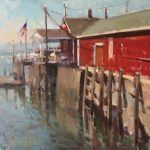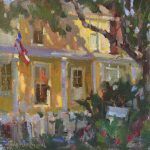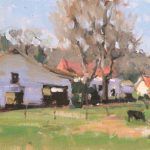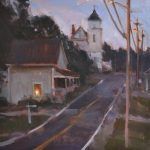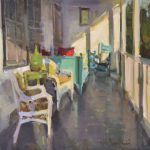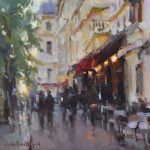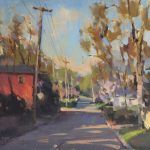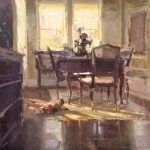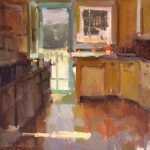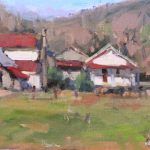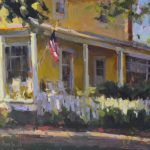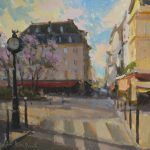Anne Blair Brown breaks free of her own artistic constraints
By Bonnie Gangelhoff
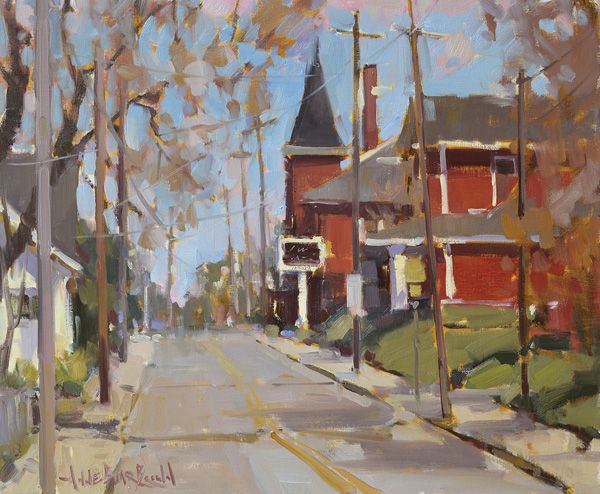
Anne Blair Brown, Show Me a Sign, oil, 20 x 24.
This story was featured in the November 2016 issue of Southwest Art magazine. Get the Southwest Art November 2016 print issue or digital download now–then subscribe to Southwest Art and never miss another story.
Several years ago, whenever artist Anne Blair Brown thought about her career, she felt blessed. She was represented by outstanding galleries, and her paintings were both selling and being juried into impressive shows. What more could an artist want? In fact, Brown did want more. The Tennessee painter realized that her success had arrived with a double-edged sword. Brown faced the fact that she had climbed aboard a treadmill of sorts, painting works because she thought her galleries could sell them. And, somewhat unwittingly, she also had pigeonholed herself as a painter of bars and café scenes. “I love to paint them, but if you are pigeonholed this way, people buy the subject matter and not the artwork,” Brown says.
So in 2012, an evolution began. Brown stepped off the fast track and into art’s slow lane. She now devotes more time to the creative process, whether it involves sitting near a Maine pier and observing lobster boats for two hours or creating monochromatic washes on the canvas for each and every painting. “If I am moved by something, I want to take time to explore it,” Brown says.
Her subject matter has expanded, too. She still paints café scenes, but now she is just as well known for home interiors, street scenes, and rural landscapes. And her style has developed into what has become her artistic signature—lush, loose, and expressive brushwork combined with harmonious color palettes. The earlier, more detailed paintings where she “just rendered stuff” have dissolved into contemporary impressionistic visions. “I started seeing things in terms of shapes, values, ideas, and more abstractly,” Brown says.
- Anne Blair Brown, American Pride, oil, 30 x 30.
- Anne Blair Brown, Early Winter Light, oil, 8 x 16.
Today her paintings continue to appear in prestigious shows and garner accolades. Earlier this year SUNNY DISPOSITION, a light-filled scene depicting her dining room on a winter afternoon, won a top award at the annual Oil Painters of America National Juried Exhibition of Traditional Oils. Another work was on view last month in the American Impressionist Society’s annual show. As this story was going to press, Brown’s solo show was opening at Simie Maryles Gallery in Provincetown, MA. Brown titled the presentation Into the Light because she felt as if she was coming “through a fog,” a difficult time in her life. “My color palette speaks to what I want now—quiet, peace, and harmony in every aspect of my life, and that includes my art,” Brown says.
Gallery owner and artist Simie Maryles, who has represented Brown for about 12 years, describes her as a representational painter who thinks abstractly. As Maryles scans Brown’s works hanging in the gallery, she notes that what they share is a sense of warmth, whether it’s a scene depicting a Maine country kitchen or an outdoor European market. “I love the painterly quality of the work,” Maryles says. “Anne’s works are a beautiful ballet of brushwork. What she is doing is celebrating the paint, color harmonies, and emotions. Anne paints from the heart, and her work is sincerely felt.”
If Brown’s paintings convey a sense of warmth, so does her studio. Indeed, the space emanates the peace and quiet she so treasures. The artist has created a world that can best be described as French-salon-meets-contemporary-New-York-loft. There are stark white walls, tall windows, and cement floors, but over all of it, an antique chandelier dangles from the ceiling. The studio is full of French bistro-style chairs and various flea-market purchases. Brown describes the studio’s ambience as “faux Louis the 14th.” It could as easily be characterized as homey and inviting.
- Anne Blair Brown, Peaceful Port, oil, 20 x 20.
- Anne Blair Brown, Porch Light, oil, 20 x 20.
- Anne Blair Brown, Promenade, oil, 12 x 12.
While plein-air painting is a favorite endeavor—“Just put me outside in a field, and I am a happy girl,” she says—time in her studio is also sacred. “I need a studio so I can reflect on what I have seen,” she says. In fact, reflecting and thinking about things in depth has always been part of Brown’s modus operandi. She was a quiet child, but her father used to say that he could practically hear the wheels turning in her head. Growing up in Nashville, Brown says, becoming a professional artist never entered her mind. But she adored drawing and building things, from model airplanes to mud sculptures. Her parents delighted in her creativity and encouraged her interests.
When it came time for college, she enrolled at the University of Georgia to pursue a bachelor’s degree in fine arts. But after graduation, lacking direction on how to pursue an art career, she headed home to Nashville. And for the next seven years she worked in the gourmet catering business, assisting classically trained chefs. “I loved the creative side of cooking,” Brown says.
Because of her culinary interests, she frequently dined out, absorbing various restaurant settings and atmospheres along the way. Eventually, however, her thoughts turned back to art. “I was beginning to think I wasn’t where I needed to be,” Brown recalls. “It was really a cosmic pull that drew me back to art. I just knew I had to paint. Divine intervention, if you will.”
In her late 20s, she enrolled in Nashville’s Watkins College of Art, Design & Film. While she had learned to draw in undergraduate classes, she learned to apply paint to canvas at Watkins. As Brown perused works from art history, she was especially taken by the French Impressionists, specifically café scenes by Edouard Manet. It seemed a natural progression for her to paint what she knew and enjoyed.
- Anne Blair Brown, Spring Light, oil, 20 x 24.
- Anne Blair Brown, Sunny Disposition, oil, 24 x 24.
- Anne Blair Brown, Cottage Kitchen, oil, 16 x 16.
Sometimes when Brown thinks back on her earlier works, she feels humbled. She now knows that she hadn’t really “arrived” in the art world as she thought. Today she believes that painting is a lifelong odyssey of learning, changing, and stepping out of comfort zones. A quote on her website’s home page from pop music icon David Bowie expresses her philosophy: “If you feel safe in the area that you’re working in, you’re not working in the right area.”
In a 2012 workshop with Quang Ho there was a foreshadowing of the artist she would become, but she didn’t realize it at the time. “When Quang told us that painting was all about shapes, I remember thinking, ‘what is he talking about?’” Brown recalls. Today, of course, her own work is a lot about shapes and impasto patches of paint she layers on the canvas until forms emerge. “It took me years to understand all that,” she says.
Brown credits, in part, a particular paintbrush with freeing up her style and allowing her to create softer edges, convey more emotion with less detail, and thus leave more to the viewer’s imagination. The Egbert brush, which has longer bristles than other brushes, was harder for her to control initially. “The Egbert took me out of the practice of holding a brush like a pencil and sticking my nose close to the canvas, so I could capture every detail,” she says.
For Brown there is a certain physicality to painting that is similar to dancing, a choreography that can include sweeping brush strokes. “I have learned not to just paint with my hand and wrist,” she says. “Painting comes from the head, goes to the heart, and then goes through the hand. Because of that I feel a lot of emotion when I paint, and I hope that translates through the brushwork.”
- Anne Blair Brown, Down in the Valley, oil, 8 x 16.
- Anne Blair Brown, Southern Morning, oil, 20 x 24.
- Anne Blair Brown, Spring Morning, oil, 20 x 20.
Sometimes those emotions are so strong that Brown hesitates to sell the work. Such is the case with the award-winning SUNNY DISPOSITION. “That is definitely a personal painting,” she says. “I have been painting interior scenes based on studies in my own house. I am drawn to warm light to create a sense of comfort and mood. My beloved cat Woody had one spot he loved—the dining-room floor where light flooded in in the afternoon. This peaceful scene moves me to the core.”
When Brown walked into her show at Simie Maryles Gallery, she burst into tears at the sight of SUNNY DISPOSITION hanging next to another painting that was also particularly personal. And she recalled shedding a tear while she was painting the scene, an experience she describes as cathartic.
For many years Brown traveled to Europe twice a year to paint. But recently she is sticking closer to home. With her current focus on light and shapes, alluring subject matter is always just around the corner. On any given warmish day, Brown says, you can find her and artist friends hanging out with the cows and donkeys at scenic farms in the Nashville countryside. While she continues to enjoy paintings by the French Impressionists, she also has come to appreciate the Russian Impressionists, who are known for a grittier style and subject matter. “Now I find beauty in crusty old shacks,” Brown says. “I don’t want to make a pretty picture to hang above a sofa. I want to capture a sense of place, evoke a sense of mystery, and convey a sense of mood, whether it’s peace or joy.”
representation
Simie Maryles Gallery, Provincetown, MA; Leiper’s Creek Gallery, Franklin, TN; Gardner Colby Gallery, Naples, FL; Brazier Gallery, Richmond, VA; Edward Montgomery Fine Art, Carmel, CA; Galeria Gardner, San Miguel de Allende, Mexico.
This story was featured in the November 2016 issue of Southwest Art magazine. Get the Southwest Art November 2016 print issue or digital download now–then subscribe to Southwest Art and never miss another story.
MORE RESOURCES FOR ART COLLECTORS & ENTHUSIASTS
• Subscribe to Southwest Art magazine
• Learn how to paint & how to draw with downloads, books, videos & more from North Light Shop
• Sign up for your Southwest Art email newsletter & download a FREE ebook






